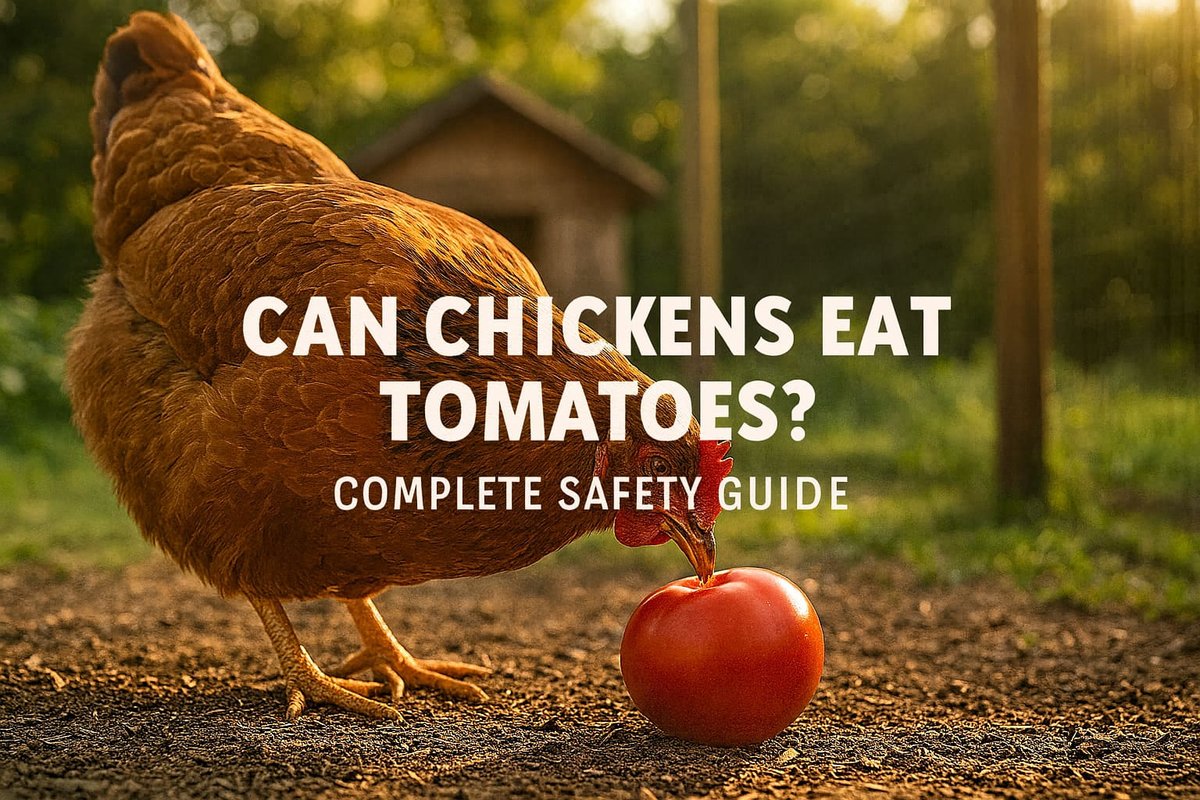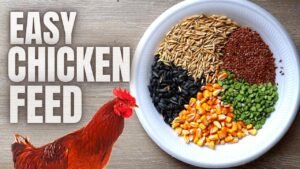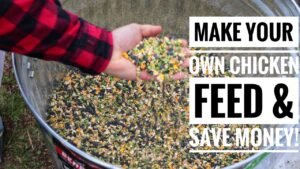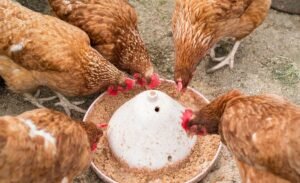Yes, chickens can eat ripe tomatoes safely. They provide great nutrients like Vitamin C, potassium, and antioxidants. However, not all parts of the tomato plant are safe. Tomato leaves, stems, and unripe green tomatoes contain toxic compounds called solanine and tomatine that can harm your flock. Ripe, red tomatoes with the stems removed make an excellent occasional treat for adult chickens. You should only feed them in moderation—about 1-2 tablespoons per bird as part of their total treat allowance.
It can be nerve-wracking trying to figure out which garden scraps are safe for your flock. As a backyard chicken keeper for over 7 years, I’ve safely fed my flock of 15 chickens (a mix of Wyandottes and Orpingtons) garden-fresh tomatoes all summer. Before feeding any kitchen scraps to your chickens, USA chicken keepers should understand the legal requirements for feeding kitchen waste to poultry.
But I learned early on from agricultural sources, like my local university extension service, that proper preparation makes all the difference. This is a key part of balanced nutrition; for example, Penn State Extension poultry nutrition guidelines state that treats should be no more than 10% of a chicken’s diet. Knowing which parts are safe is key to keeping your birds healthy and happy. Tomatoes are just one of many safe treats for your flock. For a complete overview of what chickens can and cannot eat, check out our comprehensive guide to feeding chickens.
Why Tomato Safety Matters for Your Flock
It’s important to understand why some parts of the tomato are safe and others are not. Tomatoes belong to the Solanaceae family, also known as the nightshade family. This family also includes potatoes, peppers, and eggplants.
All nightshade plants have natural compounds called alkaloids. In tomatoes, the main alkaloids are solanine and tomatine. These toxins protect the plant from pests while it’s growing. The USDA Agricultural Research Service conducts extensive research on these types of poisonous plants and their effects on livestock.
The amount of these toxins is highest in the green parts of the plant:
- Leaves
- Stems
- Flowers
- Unripe, green tomatoes
As the tomato fruit turns red and ripe, the toxin levels drop, making the fruit safe to eat. The green parts, however, stay toxic.
Important: Never feed tomato leaves, stems, flowers, or green unripe tomatoes to your chickens. These parts have solanine levels that, as confirmed by poultry veterinary resources, can cause serious illness, digestive issues, a slowed pulse, and low body temperature.
Safe vs. Toxic Parts: A Complete Breakdown
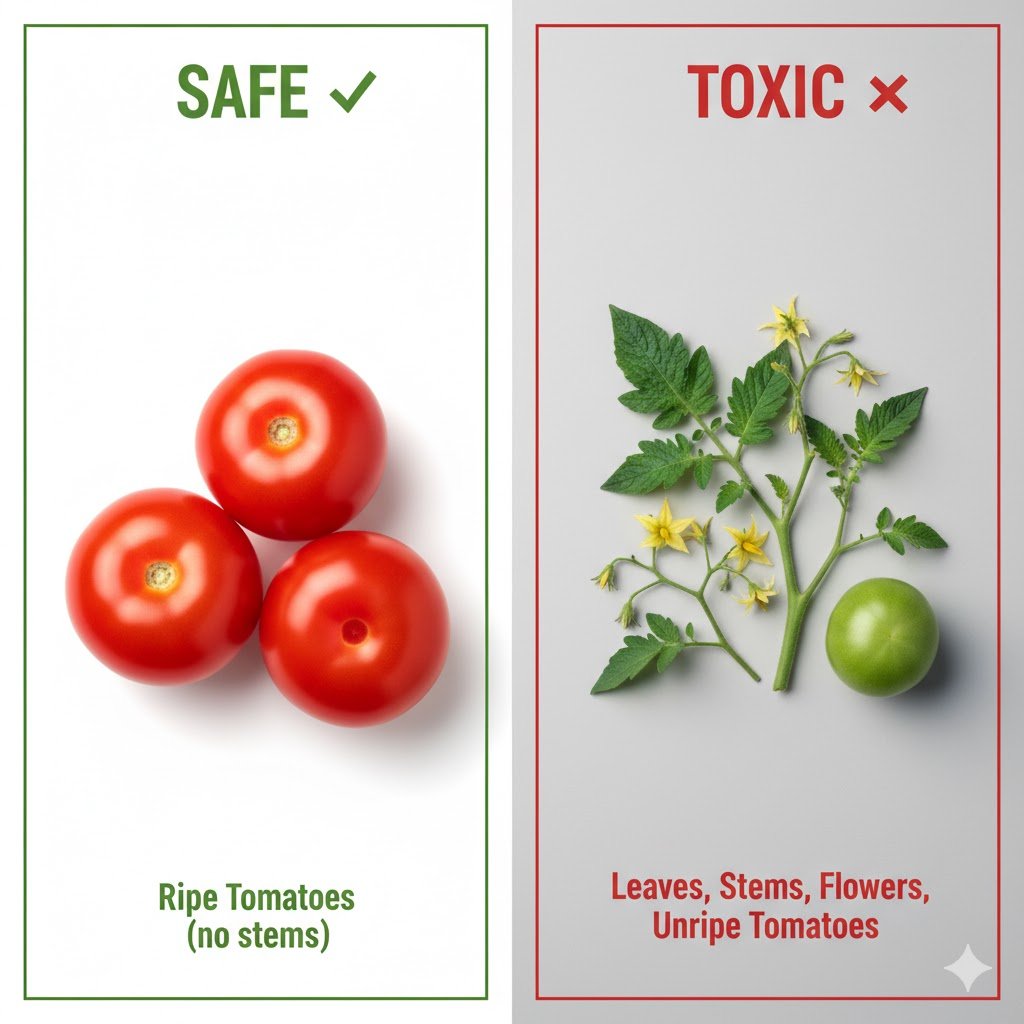
Let’s break down each part of the tomato plant so you know exactly what to feed and what to avoid.
✓ Safe: Ripe Tomato Fruit
This is the best part! All colors of fully ripe tomatoes are safe for your chickens. This includes:
- Red, orange, yellow, and even purple varieties
- Cherry tomatoes, Roma, Beefsteak, and all heirloom types
The key word is ripe. The fruit must be fully colored and softened. Ripe tomatoes are a healthy source of:
- Vitamin C: Good for the immune system, especially during hot weather.
- Potassium: An important electrolyte.
- Folate: Helps with cell growth.
- Fiber: Good for digestion.
- Lycopene: The antioxidant that makes tomatoes red.
You can feed ripe tomatoes raw or cooked. If you feed cooked tomatoes (like leftover pasta sauce), make sure it has no salt, sugar, or other seasonings. My flock goes crazy for overripe cherry tomatoes straight from the garden. They will peck through the skin and devour the flesh and seeds in minutes.
✓ Safe: Tomato Seeds
Yes, tomato seeds are completely safe for chickens. You do not need to remove them. Your chickens will eat them along with the rest of the fruit. They are not a choking hazard, as chickens’ digestive systems are built to grind up seeds and grains.
✗ TOXIC: Tomato Leaves
Tomato leaves are highly toxic. They have the highest concentration of solanine. Most chickens will avoid them because they taste bitter. However, you should never intentionally feed them. If your chickens free-range near your garden, it’s best to put up a small fence to keep them away from the tomato plants. As noted in resources like the Cornell University poisonous plants database, these alkaloids affect most livestock.
✗ TOXIC: Tomato Stems
All green stems, from the main plant to the little green top on the fruit, contain toxic alkaloids. Always remove all stems and green tops before offering tomatoes to your flock.
✗ TOXIC: Tomato Flowers
The small, usually yellow, flowers on the plant are also toxic. Chickens rarely eat them, but it’s another good reason to fence off your garden.
✗ TOXIC: Green (Unripe) Tomatoes
This is a common mistake. Never feed green, unripe tomatoes. They are high in solanine and tomatine. Only feed fully ripened, colored tomatoes. If a tomato still has green shoulders or hard green spots, wait until it’s fully ripe.
Quick Safety Chart
| Plant Part | Safe? | Notes |
|---|---|---|
| Ripe Red Tomatoes | ✓ YES | Remove stems. Feed in moderation. |
| Tomato Seeds | ✓ YES | No need to remove. |
| Cooked Tomatoes | ✓ YES | Must be unseasoned (no salt, garlic, or onions). |
| Green Tomatoes | ✗ NO | Contains solanine and tomatine toxins. |
| Tomato Leaves | ✗ NO | Highly toxic. Never feed. |
| Tomato Stems | ✗ NO | Toxic. Remove all green parts from the fruit. |
| Tomato Flowers | ✗ NO | Green parts are toxic. |
Nutritional Benefits in Detail
When fed safely, ripe tomatoes are a healthy snack.
- Hydration: Tomatoes have a high water content, making them a great treat on hot summer days. This is a great addition to knowing what to feed chickens during extreme heat.
- Vitamins: The Vitamin C helps support their immune systems.
- Nutrients: Potassium is an important electrolyte for muscle function.
- Enrichment: Tossing a few tomatoes into the run encourages natural pecking and foraging behavior, which prevents boredom.
As resources like the University of Georgia Extension emphasize, balanced nutrition is key for backyard flocks, and these treats can be a part of that, especially if you pick nutritious treats that support egg production.
Supplementing with Tomato Powder for Enhanced Egg Quality
Many poultry nutritionists now recommend adding tomato powder to layer feed to boost egg nutrients. Many poultry nutritionists now recommend adding tomato powder to layer feed to boost egg nutrients. Research shows that supplementing feed with 1-2 teaspoons of tomato powder per 2 pounds of feed increases beneficial compounds in eggs while reducing harmful oxidation. This can be an effective strategy for backyard chicken keepers looking to improve egg nutritional value naturally.
Specifically, adding 5-10 grams of tomato powder per kilogram of feed (about 1-2 teaspoons per 2 pounds) was shown to:
- Increase nutrients in eggs: It significantly boosted the amount of lycopene, beta-carotene, lutein, and Vitamin A in the egg yolks.
- Deepen yolk color: The extra carotenoids from the tomato powder resulted in richer, deeper-colored yolks.
- Improve hen health: The studies also noted a decrease in harmful malondialdehyde (MDA), suggesting better overall health for the hens.
- Boost production: Some research also pointed to an increase in egg production and overall egg weight.
This shows that the nutrients in tomatoes are not only safe but can be a valuable supplement for laying hens when provided correctly.
How to Safely Feed Tomatoes to Chickens

Ready to give your flock a treat? Here is the safe way to do it, following evidence-based guidelines for feed safety like those from the University of California Agriculture and Natural Resources program.
Preparing Tomatoes for Your Flock
- Select Ripe Tomatoes Only: Choose tomatoes that are fully colored (red, orange, etc.) and feel soft. Do not use any green tomatoes.
- Wash Thoroughly: This is very important, especially for store-bought tomatoes. Washing removes any pesticides, dirt, or sprays.
- Remove All Stems: Cut or twist off the entire green stem and calyx (the leafy top).
- Check for Mold: Overripe is fine, but moldy is dangerous. Never feed chickens moldy or spoiled food of any kind.
- Cut Large Tomatoes (Optional): Chickens will peck a whole tomato, but cutting it in half or quarters can make it easier for them to eat and creates less mess.
- Offer in Moderation: This is a treat, not a main meal. Stick to 1-2 tablespoons per bird.
Feeding Methods That Work
- Whole: I toss whole cherry tomatoes to my chickens. They treat it like a game, chasing the rolling tomatoes before pecking them open.
- Halved or Quartered: This is great for larger tomatoes like Romas or Beefsteaks.
- Mashed: You can mash up ripe tomatoes and mix a small amount into their regular feed.
- Cooked (Unseasoned): Leftover unseasoned stewed tomatoes or tomato scraps from canning (as long as they are not moldy) are also fine.
- Use a Treat Feeder: Consider using dedicated treat feeders separate from your main feeding stations. This prevents contamination and makes cleanup easier when offering juicy treats like tomatoes.
How Much Is Safe?
A good rule for all chicken treats is the 10% Rule. All treats (tomatoes, lettuce, mealworms, etc.) combined should not be more than 10% of your flock’s total diet.
Their main food must always be a complete layer feed. This gives them the right balance of protein, calcium, and nutrients for flock health and strong eggs.
A practical amount is 1-2 tablespoons of tomato per chicken, a few times per week. They are not a daily snack.
Some heritage breeds like Rhode Island Reds and Plymouth Rocks tend to have hardier digestive systems and adapt well to varied treat diets, while production breeds like Leghorns may be more sensitive. Regardless of breed, always introduce new treats gradually and monitor your flock’s response.
Seasonal Tomato Feeding: Summer Gardens to Winter Storage
Tomatoes are mostly a summer treat when gardens are overflowing.
- Summer Feeding: This is the easiest time. Feed fresh, ripe tomatoes directly from the garden (after washing and removing stems). The high water content is also great for hydrating your flock on hot days.
- Winter and Off-Season: Your chickens can’t have fresh garden tomatoes, but they can have preserved ones. If you do any canning or freezing, you can save some for your flock.
- Frozen Tomatoes: You can freeze whole ripe tomatoes. When thawed, they will be mushy, but the chickens won’t mind. They are perfectly safe and nutritious.
- Canned Tomatoes: Plain, canned, or stewed tomatoes are fine as long as they have no salt, sugar, or seasonings added. Always check the label.
- Dried Tomatoes: Unsalted, unsulfured dried tomatoes are a potent treat. Use them very sparingly as they are concentrated and lower in water.
Common Tomato-Feeding Mistakes to Avoid
Even with safe treats, it’s possible to make mistakes. Here are the most common ones I’ve seen:
- Mistake 1: Feeding Too Many Treats (The 10% Rule) This is the biggest mistake. Tomatoes are a treat, not a meal. If treats make up more than 10% of your flock’s diet, they will get an unbalanced diet, which can lead to health problems and fewer eggs.
- Mistake 2: Not Removing All Stems It’s easy to twist off the big stem but forget the little green leafy part (the calyx) that is attached to the tomato. You must remove all green parts, as they all contain toxins.
- Mistake 3: Offering Tomatoes to Broody Hens A broody hen needs to be convinced to get off the nest to eat her main, high-protein feed. Wasting her precious time and stomach space with a high-water, low-protein treat like a tomato is not a good idea. Stick to nutrient-dense food for broodies.
Can Baby Chicks Eat Tomatoes?
No, you should not feed tomatoes to baby chicks.
Chicks have very delicate, developing digestive systems. They are much more vulnerable to toxins than adult chickens. Even a tiny amount of solanine could make them sick.
Wait until your chickens are fully grown adults (at least 16-18 weeks old) before offering tomatoes. Baby chicks should eat only a high-quality “starter” or “grower” feed. Safe, simple treats for chicks (after 2-3 weeks) include a tiny bit of cooled, unseasoned scrambled egg or a few mealworms.
Can Chickens Eat Different Tomato Types?
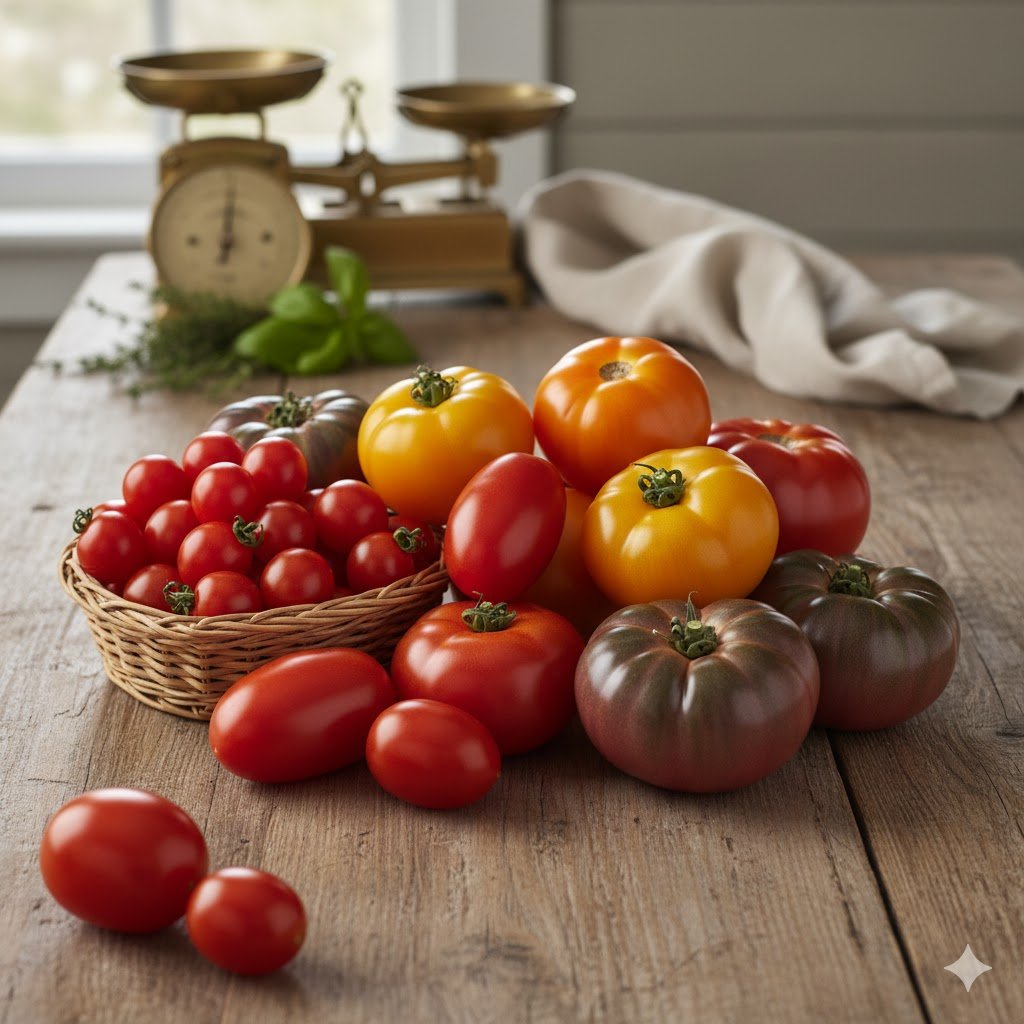
Orange and Yellow Tomatoes
Yes. All fully ripened colored tomatoes are safe. The color does not determine safety—ripeness does. Orange and yellow tomatoes are just as healthy as red ones.
Cherry and Grape Tomatoes
Yes. These are an excellent size for chickens. They are easy to toss as treats. Just make sure they are fully ripe and you pull the stems off.
Heirloom Varieties
Yes. All heirloom varieties (like Beefsteak, Brandywine, or Cherokee Purple) are safe when ripe. The same rules apply to all tomato varieties.
Green Tomato Varieties
This is a tricky one. Some tomato varieties, like “Green Zebra,” are naturally green when ripe. You should only feed these if you are 100% sure they are fully ripe. A ripe “Green Zebra” will feel soft and have yellowish-green stripes. If you are in doubt, it’s safer to just stick to the red and orange kinds.
Best Tomato Varieties for Chickens
While all ripe varieties are safe, chickens often show a preference for smaller, thin-skinned tomatoes.
- Cherry and Grape Tomatoes: These are the easiest. Their small size is perfect for a single bite, and many chickens enjoy pecking at them or even chasing them.
- Overripe Garden Tomatoes: Don’t let softer, overripe Romas or Beefsteaks go to waste. As long as they aren’t moldy, their soft texture is very easy for chickens to eat.
While all chickens can eat tomatoes, some breeds are more treat-motivated than others. My Orpingtons will devour any tomato I offer, while my Wyandottes are pickier and prefer cherry varieties.
Signs of Solanine Poisoning in Chickens
If a chicken accidentally eats tomato leaves or a large amount of green tomatoes, you need to watch for signs of solanine poisoning, which are well-documented in poultry science literature.
To put this in perspective, research suggests birds may need to consume approximately 2.5 mg of toxic plant parts per kg of body weight before showing serious symptoms. A chicken would need to eat a significant amount of leaves, not just a small nibble, to become severely ill.
Symptoms include:
- Diarrhea or watery droppings
- Lethargy (being tired and inactive)
- Loss of appetite
- Slowed pulse rate
- Lowered body temperature
- Weakness or trouble walking
If You Suspect Poisoning:
- Remove all tomato plants or green tomatoes from the chicken run immediately.
- Make sure your flock has plenty of fresh, clean water.
- Call a veterinarian who has experience with poultry. The American Veterinary Medical Association offers resources for locating poultry health specialists, and you must provide information on what was eaten and the symptoms. Learn when you should call the vet for your backyard chickens.
- Monitor the flock closely for the next 24-48 hours.
Prevention is the best cure. Fence off your tomato garden and never compost tomato plant trimmings in an area your chickens can access. Regular health monitoring helps you catch problems early, whether from toxic plants or other issues. Learn how to perform a complete chicken health check.
Growing Tomatoes Safely with Free-Range Chickens
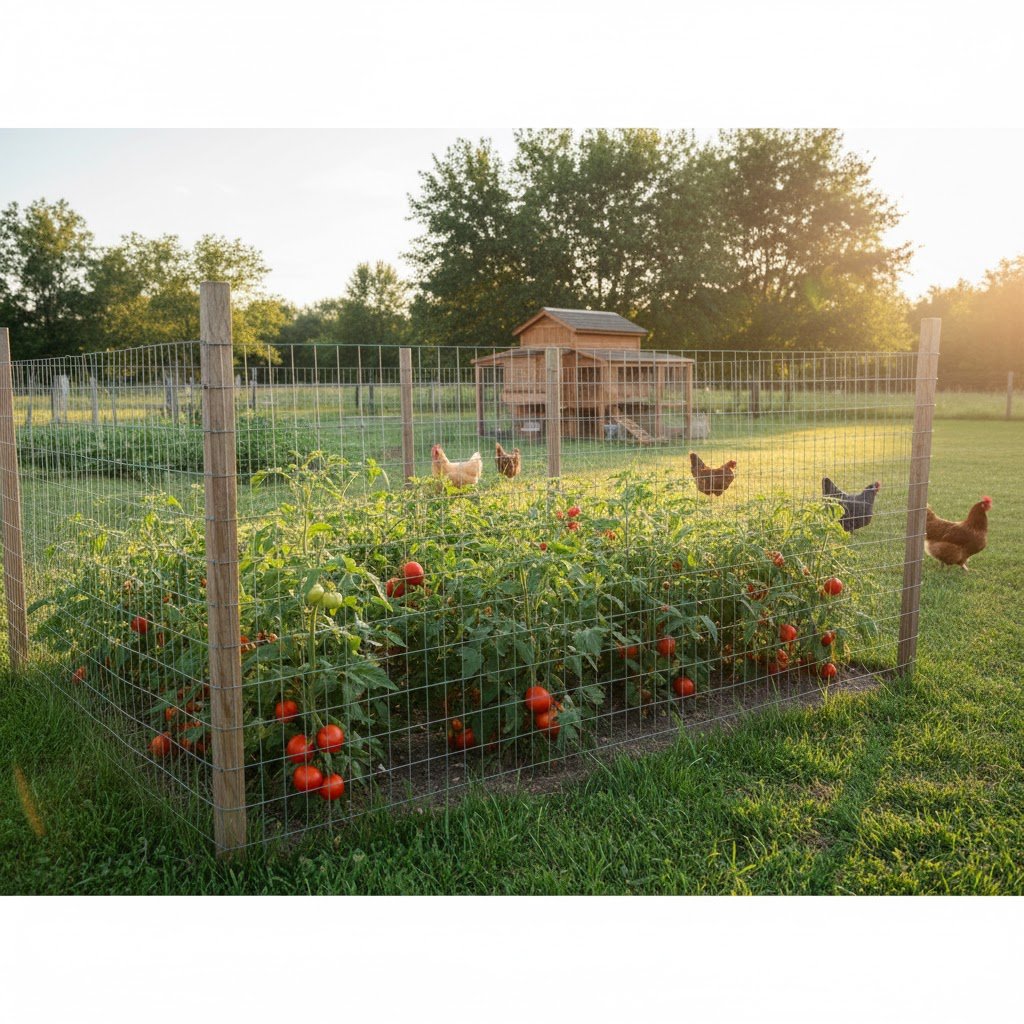
Having a garden and free-range chickens can be tricky. Here’s how to manage it safely:
- Fencing is Non-Negotiable: You must fence off your tomato plants. A simple chicken wire or hardware cloth fence is usually enough to keep chickens out. This not only protects your chickens from the toxic leaves but also protects your ripe tomatoes from being stolen!
- Harvest Timing: Harvest all ripe tomatoes promptly. Don’t let them fall and rot on the ground where chickens might get them. More importantly, pick up any fallen unripe, green tomatoes that might get knocked off during a storm.
- Companion Planting: While not a direct safety feature, planting strong-smelling herbs like marigolds or mint around the outside of your garden fence can sometimes help deter chickens (and pests) from being too curious.
- Disposal: When you prune your tomato plants, immediately remove the trimmings from the area. Do not toss them into the chicken run or a compost pile that your chickens can access.
Beyond Tomatoes: Other Nightshades and Toxic Plants
Tomatoes are not the inly plant to be careful with. Here are a few other common toxic foods and plants. For a complete reference, Cornell University maintains a comprehensive database of plants toxic to livestock, and Purdue University Extension publishes comprehensive guides on identifying toxic plants.
- Other Nightshades:
- Potatoes: Never feed raw potatoes, green potatoes, or potato peels. They are high in solanine. (Cooked, white potatoes are safe as a treat).
- Peppers: The ripe fruit (red, yellow, orange) is safe. The leaves and stems of the plant are toxic.
- Eggplants: The ripe fruit is safe. The leaves and stems of the plant are toxic.
- Additional Toxic Foods: Beyond nightshades, I’ve learned to keep my flock away from several other dangerous foods. Avocados contain persin, which I discovered after nearly composting an avocado pit near the run—thankfully I caught myself in time. Onions are another big no-no, as they can cause anemia in chickens. You also need to be careful with apple seeds (they have small amounts of cyanide), rhubarb leaves, and any dried or uncooked beans. And, of course, never feed any food that is moldy or spoiled.
- Common Toxic Garden Plants: Azalea, Foxglove, Lily of the Valley, Oleander, and Yew are all very poisonous to chickens.
Other Safe Vegetables and Fruits for Chickens
Want to mix up your flock’s treat routine? Here are other great options:
- Cucumbers
- Watermelon (seeds and flesh are fine)
- Berries (blueberries, strawberries, etc.)
- Squash and Zucchini
- Leafy greens (like lettuce, kale, and spinach, but only in moderation)
- Pumpkin (raw or cooked). Pumpkin is another excellent treat. Learn everything about safely feeding pumpkins to chickens including seeds and rinds.
- Carrots (raw or cooked)
- Apples (just remove the seeds)
Want to know what other kitchen scraps are safe for your flock? Learn which everyday foods from your kitchen chickens can safely eat.
Common Questions About Chickens and Tomatoes
Q: Can chickens eat tomato plant trimmings?
A: No. All green parts, including trimmings, pruned leaves, and cut stems, contain toxic alkaloids. Dispose of all tomato plant waste far away from your flock.
Q: Are tomato leaves poisonous to birds?
A: Yes, tomato leaves contain solanine which is toxic to most birds, including chickens, wild birds, and pet birds. The alkaloid affects their nervous and digestive systems similarly.
Q: What are tomato plant leaves good for?
A: Tomato leaves have no safe use for chickens or other poultry. While some gardeners use them as natural pest deterrents in gardens, they should never be fed to livestock. Dispose of tomato plant trimmings in compost areas away from your flock.
Q: Which plants are poisonous to chickens?
A: Beyond tomato plants, common toxic plants include avocado (skin and pit), raw potatoes, onions, apple seeds, rhubarb leaves, azalea, foxglove, and oleander. All nightshade family plants (potatoes, peppers, eggplants) have toxic leaves and stems.
Q: What animals can safely eat tomato leaves?
A: Very few. Most mammals and birds will naturally avoid them because they taste bad. Never intentionally feed tomato leaves to any livestock or pets.
Q: Can chickens eat tomato sauce?
A: Yes, but only if it is unseasoned. Plain, cooked-down tomatoes or tomato sauce with no salt, sugar, onions, or garlic is safe. Most store-bought sauces contain high levels of salt and other ingredients that are unhealthy for chickens.
Q: How much tomato is too much for chickens?
A: Any treat is “too much” if it makes up more than 10% of your flock’s daily diet. For tomatoes, a good guide is 1-2 tablespoons per chicken, a few times a week. Too many treats can lead to an unbalanced diet and health problems.
Q: Can chickens eat tomatoes from the store?
A: Yes, as long as you wash them very well to remove any pesticides and remove all the stems. Store-bought ripe tomatoes are just as safe as garden tomatoes once they are cleaned.
Q: Do I need to cook tomatoes for chickens?
A: No, raw ripe tomatoes are perfectly safe. However, cooked unseasoned tomatoes are also fine. Never add salt, sugar, or seasonings.
Q: Will tomatoes change my eggs’ color or taste?
A: No. Feeding small amounts of fresh tomatoes in moderation will not have any noticeable impact on your eggs’ color or taste. The scientific studies that saw changes in yolk color used a consistent, concentrated amount of dried tomato powder in the daily feed, which is different from feeding fresh tomatoes as an occasional treat.
Q: Can chickens eat canned tomatoes?
A: Yes, but only if they are plain and have no salt or seasonings. Check the label very carefully. Many canned tomatoes have added salt, which is not good for chickens.
Q: Can chickens eat sun-dried tomatoes?
A: It’s best to be very careful. Plain, unsalted, and unsulfured dried tomatoes are safe in very small amounts (think one tiny piece per chicken). They are highly concentrated. However, most sun-dried tomatoes are packed in oil or with lots of salt, which are both bad for your flock.
Q: What should I do if my chicken ate tomato leaves?
A: First, don’t panic. Most chickens avoid the leaves because they are bitter, so they likely only had a small nibble.
Final Thoughts: Keeping Your Flock Safe
Understanding what to feed your chickens is essential for new keepers. Avoid common mistakes every first-time chicken keeper makes when starting out.
Here are the biggest takeaways:
- Ripe tomatoes are a nutritious, safe treat in moderation.
- Always remove stems and avoid all green parts (leaves, stems, unripe fruit).
- Never feed tomatoes to baby chicks. This is a treat for adult chickens only.
- Remember the 10% treat rule: 90% of their diet must be a complete layer feed.
- When in doubt about ripeness, wait another day or two.
- Fence off your garden tomato plants to keep your flock safe.
The most important thing is to be a careful, observant owner.

Oladepo Babatunde is the founder of ChickenStarter.com. He is a backyard chicken keeper and educator who specializes in helping beginners raise healthy flocks, particularly in warm climates. His expertise comes from years of hands-on experience building coops, treating common chicken ailments, and solving flock management issues. His own happy hens are a testament to his methods, laying 25-30 eggs weekly.
